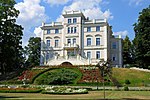Herrensee (Waren)

The Herrensee is a small lake on the northwestern edge of the old town (Altstadt) of Waren (Müritz) in the district of Mecklenburgische Seenplatte in the German state of Mecklenburg-Western Pomerania. The originally almost-circular lake was slightly enlarged on its southern shore during the construction of the Information and Nature Experience Centre of Müritzeum. It has an approximate area of 1.5 hectares and a diameter of 130 metres. The lake is filled from the east by the Beke that carries water from the Tiefwarensee, 230 metres away, and is also drained by the Beke to the southwest into the Binnenmüritz just 70 metres away. The lake contains several small bush-covered islets that are used as nesting sites by water fowl. The Herrensee lies on the edge of a small park and there is a nature trail running around it. It gives its name to the bridge that divides the park, the Herrensee Bridge (Herrenseebrücke), which runs over the B 192 federal road and the Lloyd Railway and links the Old Town to the quarter of Waren-Nord.
Excerpt from the Wikipedia article Herrensee (Waren) (License: CC BY-SA 3.0, Authors, Images).Herrensee (Waren)
Herrenseebrücke,
Geographical coordinates (GPS) Address Nearby Places Show on map
Geographical coordinates (GPS)
| Latitude | Longitude |
|---|---|
| N 53.51583 ° | E 12.68361 ° |
Address
Herrenseebrücke
17192 , Werdersiedlung
Mecklenburg-Vorpommern, Germany
Open on Google Maps








